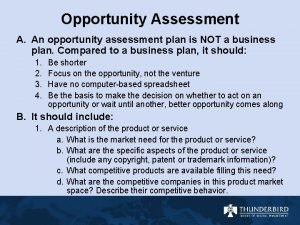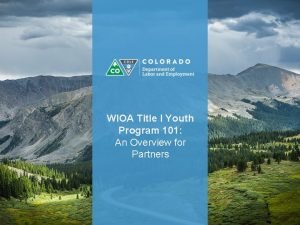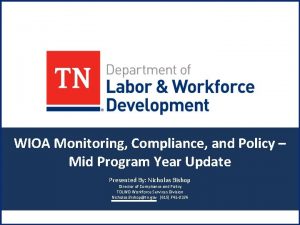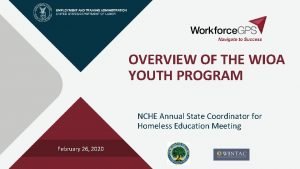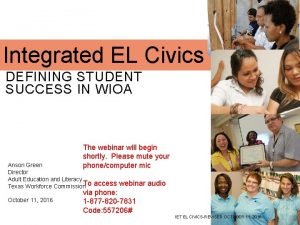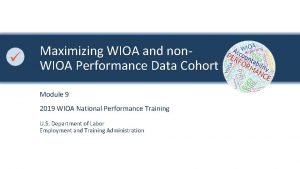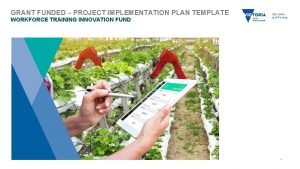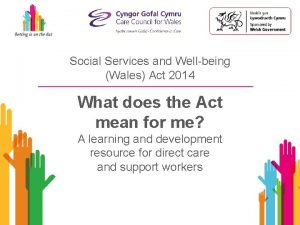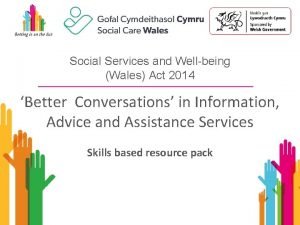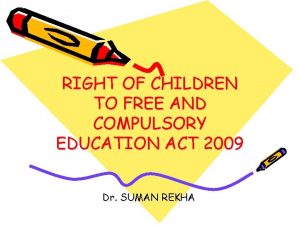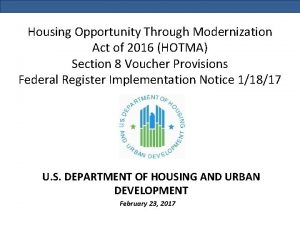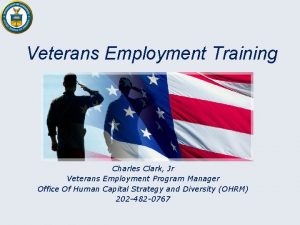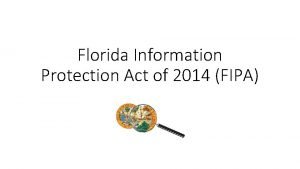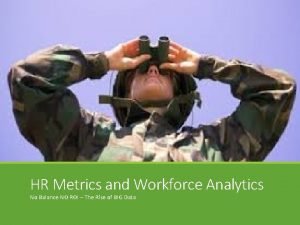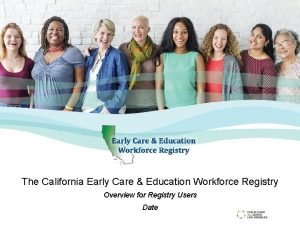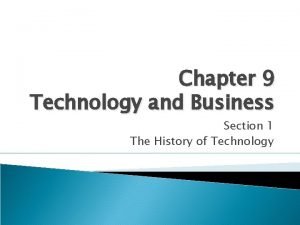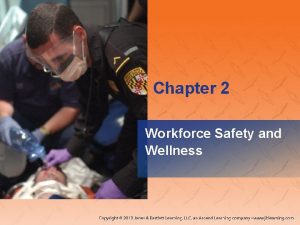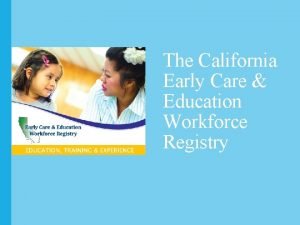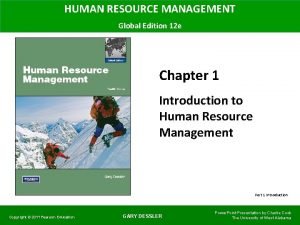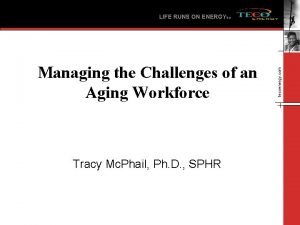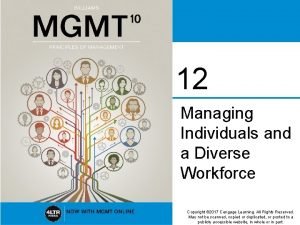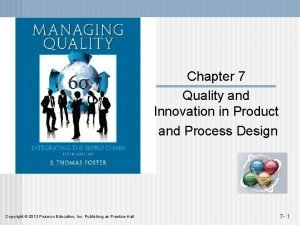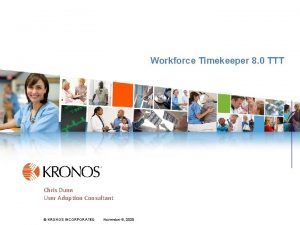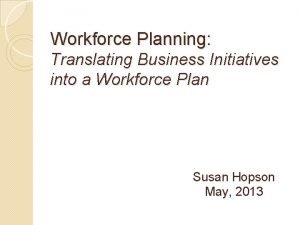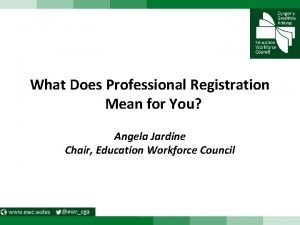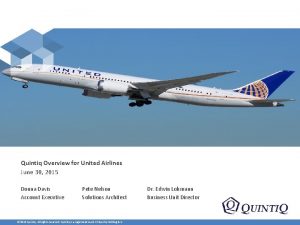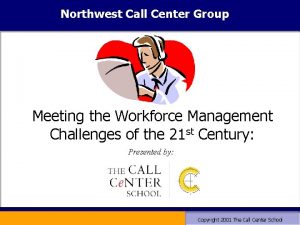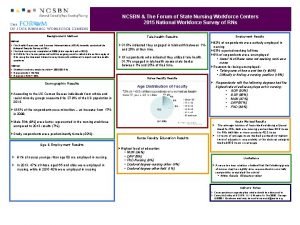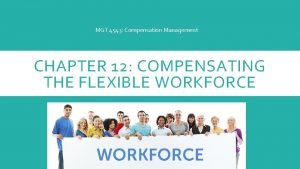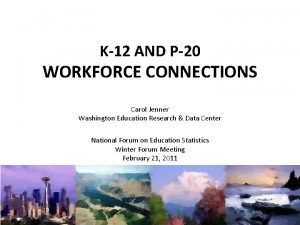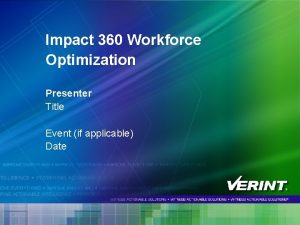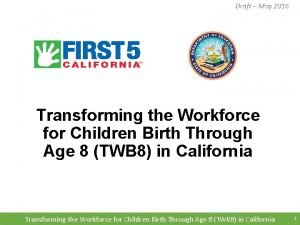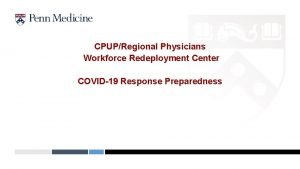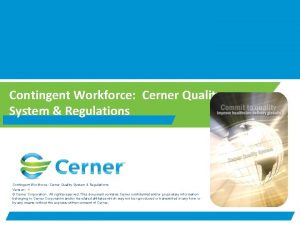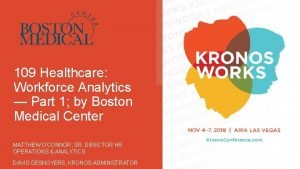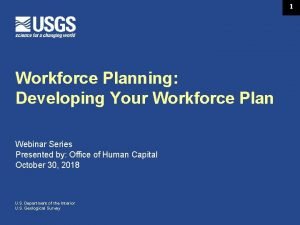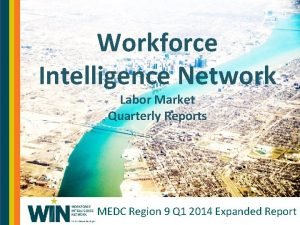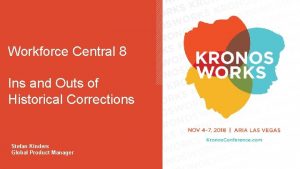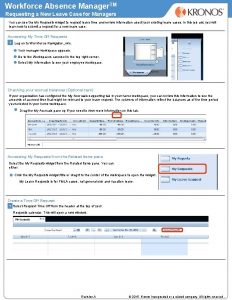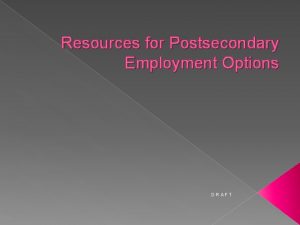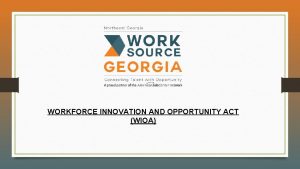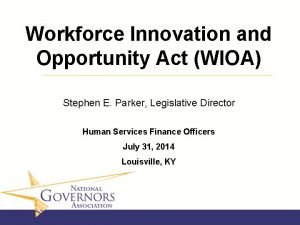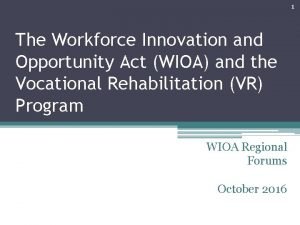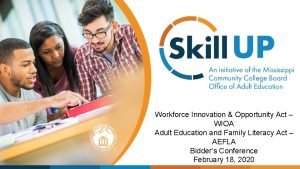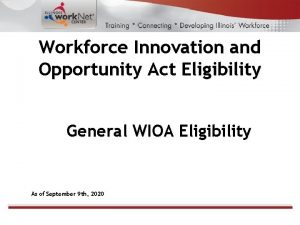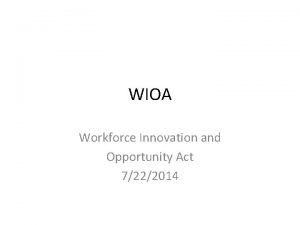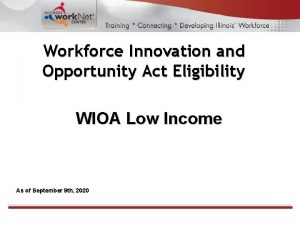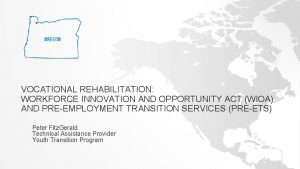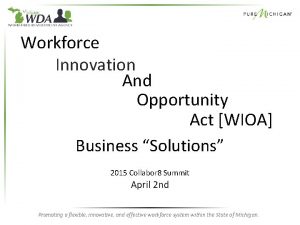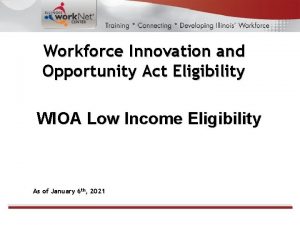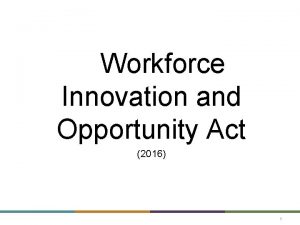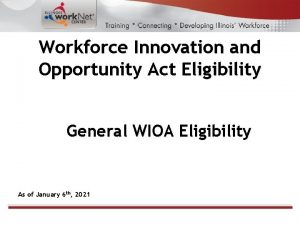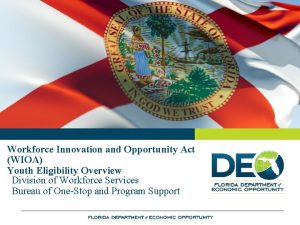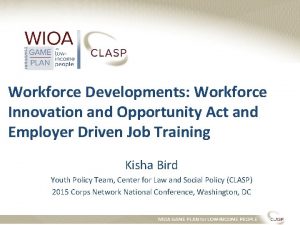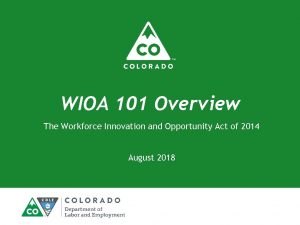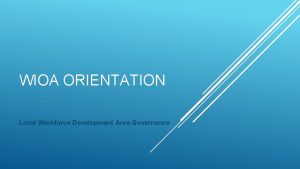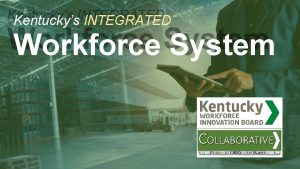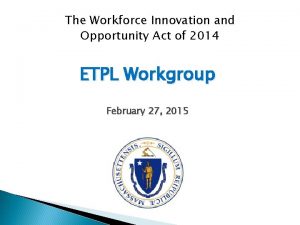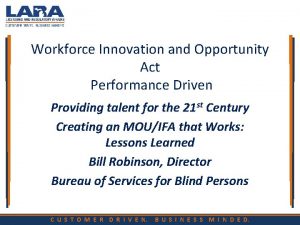Workforce Innovation and Opportunity Act WIOA of 2014

























































- Slides: 57

Workforce Innovation and Opportunity Act (WIOA) of 2014, Title II Adult Education and Family Literacy Act (AEFLA) Bidder’s Conference for 2017 -2019 Talent Investment Agency Office of Adult Education adulted@michigan. gov 1

Today’s Goals § Walk through the Guidance and Instructions and applications. § Write down any questions during the presentation. § Staff will address all questions at the end of the power point and provide any additional guidance necessary. § Questions and answers and this powerpoint will be posted on the Office of Adult Education website. 2

Important Information § Applications are due by 5: 00 pm on April 7, 2017. § Applications must be submitted via email to adulted@michigan. gov. § Successful applicants will be notified in June and published on the Office of Adult Education website. 3

Important Information Applicants need to be familiar with the: § Law (WIOA, Title II, AEFLA) § Preambles for the applicable regulations § Local workforce development plan § Guidance and Instructions § Applications 4

Important Information § This is a two year grant cycle (2017 -2019), but an application must be submitted and approved through the Michigan Electronic Grants System (MEGS+) each year. § The federal grant year is from July 1, 2017 through June 30, 2018. 5

Important Information § Successful grantees will enter their application into MEGS+. Applications will be reviewed for allowable activities and expenditures. § Information will be provided to successful grantees about using MEGS+, including directions and training for agencies new to MEGS+. § Once approved in MEGS+, grant funds will be made available and can be drawn down through the Cash Management System (CMS). § Both MEGS+ and CMS are administered by Michigan Department of Education. 6

GUIDANCE AND INSTRUCTIONS 7

Workforce Innovation and Opportunity Act (WIOA) § Signed into law by President Obama on July 22, 2014 § Encourages new opportunities for innovation and collaboration across the federal and state agencies § Under WIOA, each state agency is required to competitively award multi-year grants to eligible providers § The state agency is required to ensure direct and equitable access to the application 8

Four Titles under WIOA § Title I – Adults, Youth and Dislocated Workers § Title II – Adult Education § Title III – Wagner-Peyser Employment Services § Title IV – Vocational Rehabilitation Program 9

Grant Purpose - AEFLA § Assist adults to become literate and obtain the knowledge and skills for employment and economic self-sufficiency; § Support the educational and skill achievement of parents and family members to participate in the educational development of their children and improve economic opportunities for families; § Assist immigrants and English learners in improving their English and math proficiency and understanding of the rights and responsibilities of citizenship; and § Assist incarcerated individuals in strengthening their knowledge and skills to promote successful re-entry into society. 10

Adult Education and Family Literacy Services § Adult Basic Education (ABE) § Adult Secondary Education (ASE) § High School Equivalency Preparation (HSE) § High School Completion (HSC) § English as a Second Language (ESL) 11

Adult Education and Family Literacy Services § Family Literacy § Workplace Literacy § Workforce Preparation § Integrated Education and Training (IET) § Integrated English Language and Civics Education (IELCE) 12

Meeting the Requirement for the Three Components to be Integrated Services must be provided concurrently and contextually such that— a) Within the overall scope of a particular integrated education and training program, the adult education and literacy activities, workforce preparation activities, and workforce training: 1) Are each of sufficient intensity and quality, and based on the most rigorous research available, particularly with respect to improving reading, writing, mathematics, and English proficiency of eligible individuals; 2) Occur simultaneously; and 3) Use occupationally relevant instructional materials. 13

Meeting the Requirement for the Three Components to be Integrated b) The integrated education and training program has a single set of learning objectives that identifies specific adult education content, workforce preparation activities, and workforce training competencies, and the program activities are organized to function cooperatively. 14

Eligible Applicants WIOA Section 203(5): An organization that has demonstrated effectiveness in providing literacy services to eligible participants, and may include: (A) a local educational agency; (B) a community-based organization or faith-based organization; (C) a volunteer literacy organization; (D) an institution of higher education; 15

Eligible Applicants (E) a public or private nonprofit agency; (F) a library; (G) a public housing authority; (H) a nonprofit institution that has the ability to provide adult education and literacy activities to eligible individuals; (I) a consortium or coalition of the agencies, organizations, etc. ; (J) a partnership between an employer and an entity described above. 16

Eligibility Requirements to have Application Reviewed § Agency must be a direct provider of adult education services § Must show demonstrated past effectiveness § Data provided must be verifiable by our office 17

Demonstrated Effectiveness 34 CFR 463. 24 § Past effectiveness of the eligible provider in improving the literacy of eligible individuals, especially with respect to eligible individuals who have low levels of literacy; § Outcomes for eligible participants related to employment, attainment of secondary school diploma or its recognized equivalent, and transition to post secondary education and training. 18

Demonstrated Effectiveness § Agencies that have attained less than 50% of the overall 2015 Educational Functioning Level (EFL) benchmark will not be scored. § Please enter your overall EFL gain rate in the first table on page 5 of the grant application(s). 19

Demonstrated Effectiveness 20

Demonstrated Effectiveness Criteria Entering Educational Functioning Level ABE Beginning Literacy ABE Beginning Basic Education ABE Intermediate Low ABE Intermediate High ASE Low ESL Beginning Literacy ESL Beginning Low ESL Beginning High ESL Intermediate Low ESL Intermediate High ESL Advanced Total 2015 -2016 Targets 44% 42% 37% 31% 34% 57% 65% 60% 47% 44% 20% 41% 50% of Target 22. 0% 21. 0% 18. 5% 15. 5% 17. 0% 28. 5% 32. 5% 30. 0% 23. 5% 22. 0% 10. 0% 20. 5% 21

Local Contributions AEFLA funds are supplemental funds and thus cannot be the sole funding source supporting a program. § WIOA Section 241(a) Supplement and not Supplant § Local share funding for adult education services § State School Aid Act, Section 107 funding 22

Regional Distribution of Funding § 15% of those who are not high school graduates age 18 to 24 * § 60% of those who are not high school graduates age 25 or older * § 25% of those who are not high school graduates age 18 and older who lack basic English language proficiency *as reported by the most recent 5 -year estimates from the American Community Survey (ACS) from the United States Census Bureau. TIA reserves the right to conduct a subsequent competitive bid process in one or more regions, and to redistribute a portion or all of a region’s allocation as appropriate. 23

Regional Requirements § Each prosperity region will be required to provide comprehensive services, including adult basic education, adult secondary education, high school completion, high school equivalency, English as a second language, and opportunities for integrated education and training. § Sub-recipient may only provide services within its region. 24

Regional Partnerships § WIOA requires collaboration at all levels – federal, state, and local and – between core programs § Formation of regional partnerships that align multiple resources to provide comprehensive services to learners § Coordination with Federal, State, and local support services for support services § At a minimum, such partnerships should include adult education partners, postsecondary education, vocational rehabilitation, and workforce development agencies. 25

Regional Partnerships § Priority given to applicants with strong collaborative partnerships, and § Effective strategies to deal with diverse populations and barriers to employment, including: • • • Low basic skills, English language learners, Low income participants, Individuals with disabilities, Single parents, and Displaced homemakers. 26

One-Stop Partner Requirements Under WIOA, each required partner must: § Provide access to its programs or activities through the one-stop delivery system, in addition to other appropriate locations; AND § Use a portion of administrative funds to provide applicable career services and work collaboratively with the state and local workforce board to establish and maintain the one-stop delivery system, which includes jointly funding the one-stop infrastructure through partner cash, noncash, or third-party contributions. § Adult education providers that receive AEFLA funding assume the roles and responsibilities of one-stop partners, including contributing to infrastructure costs. 27

Infrastructure Costs § Infrastructure costs are the responsibility of all onestop partners, whether they are physically located in the one-stop center or not. – May include cash, in-kind and third party contributions § Each partner’s contribution to these costs may vary- contributions to be based on the proportional use and relative benefit received by each program. 28

Program Design Requirements § NRS (National Reporting System) state-approved assessments must be used to place learners in the correct program of enrollment – CASAS – TABE CLAS-E – GAIN § Adult Learning Plan must be used for all learners 29

Primary Indicators of Performance I. the percentage of program participants in unsubsidized employment in the 2 nd quarter after exit; II. the percentage of program participants in unsubsidized employment in the 4 th quarter after exit; III. median earnings of program participants who are employed during the 2 nd quarter after exit; IV. the percentage of program participants who obtain a recognized postsecondary credential, or a secondary school diploma or its recognized equivalent (subject to clause (iii))* during participation in or within 1 year after exit; 30

Primary Indicators of Performance V. the percentage of program participants achieving measurable skill gains; and VI. effectiveness in serving employers. *Clause (iii) states that program participants who obtain a secondary school diploma or its recognized equivalent shall be included in the percentage counted as meeting the criterion only if, in addition to obtaining diploma or equivalent, they have obtained or retained employment or are in an education or training program leading to a postsecondary credential within 1 year after exit from the program. (Section 116(b)(2)(iii)) 31

2017 -2018 Federal Performance Measures OVERALL MEASURABLE SKILLS GAINS 2017 -2018 Program Type MSG Target % Adult Basic Education (ABE + ASE) 37% English as a Second Language (ESL) 52% OVERALL MSG 42% 32

2017 -2018 Federal Performance Measures Entering Educational Functioning Level ABE Beginning Literacy ABE Beginning Basic Education ABE Intermediate Low ABE Intermediate High ASE Low ESL Beginning Literacy ESL Beginning Low ESL Beginning High ESL Intermediate Low ESL Intermediate High ESL Advanced 2017 -2018 Targets 46% 39% 36% 30% 36% 58% 67% 60% 51% 52% 33

Data Entry Requirements § Michigan Adult Education Reporting System (MAERS) § States are required to report into the NRS § All federal and state funded adult education programs must enter data into MAERS § For every adult education participant that registers for services and attends one or more instructional hours 34

Deadlines for Data § Data must be entered monthly, at a minimum § August 1 st following the end of the program year for participant registration, assessment, class enrollment, and attendance data § September 30 th following the end of the program year for planned gaps, interim achievements, program exits, and outcome data 35

Program Monitoring and Compliance § Local programs are responsible for managing the grant to assure that all funding and performance requirements are in compliance with applicable federal and state requirements. § TIA will monitor programs to ensure compliance with federal and state regulations 36

Financial Requirements § All sub-recipients must follow WIOA Title II and Uniform Grant Guidance regulations § Sub-recipients must request federal funds on a reimbursement basis at least quarterly in the Cash Management System (CMS) § Sub-recipients that expend $750, 000 or more in federal awards during the fiscal year must have an independent single audit § Sub-recipients are required to follow federal procurement standards when purchasing contractor/vendor services 37

Financial Requirements § WIOA Section 233(a)(2)-5% administrative cost limit § Remaining amount for adult education and literacy activities § Allowable costs-programmatic and instructional § Must track required partner infrastructure costs § HSE testing costs are unallowable § Must track and report Tuition and Fees 38

Final Reporting Requirements § Final Expenditure Report - August 29, 2018 § Final Narrative Report - November 30, 2018 § Single audit, if applicable 39

APPLICATIONS 40

Applications § 3 separate applications: – General Instruction – Institutional – Integrated English Language and Civics Education (IELCE) § Narratives are similar § Please read the applications and Guidance and Instructions § Certifications and Assurances 41

Scoring Rubric-Funding Considerations § Applicant must first meet eligibility qualifications to have application reviewed and scored. § Must score at least 80 points to be considered for funding. § Be thorough in your application, as not all reviewers will be from adult education. § Local workforce development board will review applications for alignment to the local plan, but will not score applications. § Number of grants awarded depends on number of proposals received and amount of funds requested. 42

Scope of Work The applicant must use the funding to establish an Adult Education program in accordance to the WIOAAEFLA requirements. Consider: § How adult education services are designed to meet the needs of the region, identified in the local plan. § How the program will provide comprehensive services. § How the program ensures that participants receive instruction in specific programs of enrollment. § How the program integrates with the local workforce system. 43

General Instruction Grant Section 231 Comprehensive adult education services that may be provided: § Adult education § Literacy § Workplace adult education and literacy activities § Family literacy activities § English language acquisition activities § Integrated English literacy and civics education § Workplace preparation activities, or § Integrated education and training 44

Program Design and Implementation Strategies The applicant must have proactive strategies that address and eliminate barriers for adult learners including participant access to services and navigating the system in accordance to the WIOA-AEFLA requirements. 45

Instructional Practices The applicant must provide evidence of their ability to deliver high-quality instruction to eligible individuals. § Provide evidence of applicant’s ability to deliver high -quality instruction to eligible individuals § Workforce preparation activities § Contextualization of instruction § Provide detailed examples 46

Transition Strategies The applicant must provide transitional services that assist the adult learner with the attainment of a secondary school diploma or its recognized equivalent; and transition to postsecondary education and training; or employment. Consider: § Proactive strategies § How will the agency provide effective transitional services? § How will the agency align services with regional partners? 47

Professional Development and Staffing Strategies The applicant must develop a professional development plan that meets specialized training needs for high-quality instruction that is of sufficient intensity and quality, and based on the most rigorous research and methods. § How is the agency determining staffing and professional development needs? 48

Michigan Works! Agencies (MWAs) The applicant must have ongoing meetings with their local Workforce Development Boards and Michigan Works! Agency staff to ensure proactive strategies are being developed to implement the proposed activities in this plan. § § § Collaboration strategies Participant access to workforce programs One-stop partner responsibilities Infrastructure costs MWA access to adult education programs Application alignment with local workforce plan 49

Collaborative Partners § Instructional grant: The applicant must describe any current/proposed strategies for developing collaborative partnerships with organizations that have expertise or resource information relevant to the proposed adult education program. § Institutional grant: The applicant must describe any current/proposed strategies for developing collaborative partnerships with organizations that have expertise or resource information relevant to the proposed Corrections Education program. 50

Collaborative Partners § IELCE: The applicant must describe any current/proposed strategies for developing collaborative partnerships with organizations that have expertise or resource information relevant to the proposed IELCE program. § For all applications- the intent is to provide support services and training through collaborations. 51

Grants Management § Administrative-key staffing and professional development § Performance Reporting-strategies for timely and accurate data reporting § Past Effectiveness-in improving the literacy of eligible individuals, especially those with low levels of literacy 52

Budget Worksheet § Budget developed for adult education and literacy services allowable under AEFLA § Administrative costs cannot exceed 5% § Line item costs must be allocable, allowable, reasonable and necessary to meet the performance of the grant § May not supplant other local or state funds § Must be detailed and transparent 53

Institutional Grant Section 225 Comprehensive adult education services that may be provided: § § § § adult education and literacy activities; special education, as determined by the state office; secondary school credit; integrated education and training; career pathways; concurrent enrollment; peer tutoring; transition to re-entry initiatives and other post release services with the goal of reducing recidivism. Cannot use Instruction funds for Institutional services. 54

Requirements for IELCE Program Eligible Providers Eligible providers must provide services that— a) Include instruction in literacy and English Language acquisition and instruction on the rights and responsibilities of citizenship and civic participation, and b) are designed to: o o Prepare adults who are English Language Learners (ELLs) for and place such adults in, unsubsidized employment in in-demand industries and occupations that lead to economic self-sufficiency; and Integrate with the local workforce development system and its functions to carry out the activities of the program. 55

IELCE Program Components English + Language Literacy Acquisition Civics Education Must meet all of the requirements in Subpart D Provided in combination with IET Adult Workforce + Education & Preparation Literacy Activities Workforce Training (specific sector) Must meet all of the requirements in Subpart D 56

Questions? adulted@michigan. gov Thank you! 57
 Opportunity assessment plan
Opportunity assessment plan Wioa youth program elements
Wioa youth program elements Wioa
Wioa Wioa
Wioa Wioa
Wioa Wioa optimized system
Wioa optimized system Wioa maryland
Wioa maryland Grant implementation plan example
Grant implementation plan example Workforce innovation fund
Workforce innovation fund Mysite socccd
Mysite socccd Radical vs disruptive innovation
Radical vs disruptive innovation Social services and wellbeing act principles
Social services and wellbeing act principles Social services and wellbeing (wales) act 2014 easy read
Social services and wellbeing (wales) act 2014 easy read Salient features of rte 2009
Salient features of rte 2009 Macbeth summary
Macbeth summary Housing opportunity through modernization act
Housing opportunity through modernization act Veteran employment opportunity act
Veteran employment opportunity act Care act 2014
Care act 2014 Florida information protection act of 2014
Florida information protection act of 2014 Hr metrics and workforce analytics
Hr metrics and workforce analytics California workforce registry
California workforce registry What is the difference between e-workforce and e-commerce?
What is the difference between e-workforce and e-commerce? Workforce safety and wellness chapter 2
Workforce safety and wellness chapter 2 California workforce registry
California workforce registry Indebtedness and deregulation in hrm
Indebtedness and deregulation in hrm Managing the aging workforce challenges and solutions
Managing the aging workforce challenges and solutions Surface-level diversity
Surface-level diversity Opportunities challenges
Opportunities challenges Quality and innovation in product and process design
Quality and innovation in product and process design Human act and act of man
Human act and act of man R.a. 9344
R.a. 9344 How to fix a missed punch in kronos
How to fix a missed punch in kronos Workforce analysis
Workforce analysis Education workforce council
Education workforce council Managerial judgement workforce planning
Managerial judgement workforce planning Workforce planning nedbank
Workforce planning nedbank Quintiq workforce planner
Quintiq workforce planner Regional centers for workforce transformation
Regional centers for workforce transformation Call center school workforce management
Call center school workforce management National forum of state nursing workforce centers
National forum of state nursing workforce centers Compensating the flexible workforce
Compensating the flexible workforce P20 workforce
P20 workforce Impact 360 workforce management
Impact 360 workforce management Transforming the workforce
Transforming the workforce Workforce redeployment
Workforce redeployment Workforce.cerner
Workforce.cerner Offender workforce development specialist
Offender workforce development specialist Digital ready workforce
Digital ready workforce Avaya crqm
Avaya crqm Role segmentation workforce planning
Role segmentation workforce planning Bmc kronos
Bmc kronos Workforce analysis
Workforce analysis Oakland community college
Oakland community college Kronos workforce central 8
Kronos workforce central 8 Workforce absence manager
Workforce absence manager Workforce flow
Workforce flow School workforce census 2017
School workforce census 2017 Lousiana workforce commission
Lousiana workforce commission
